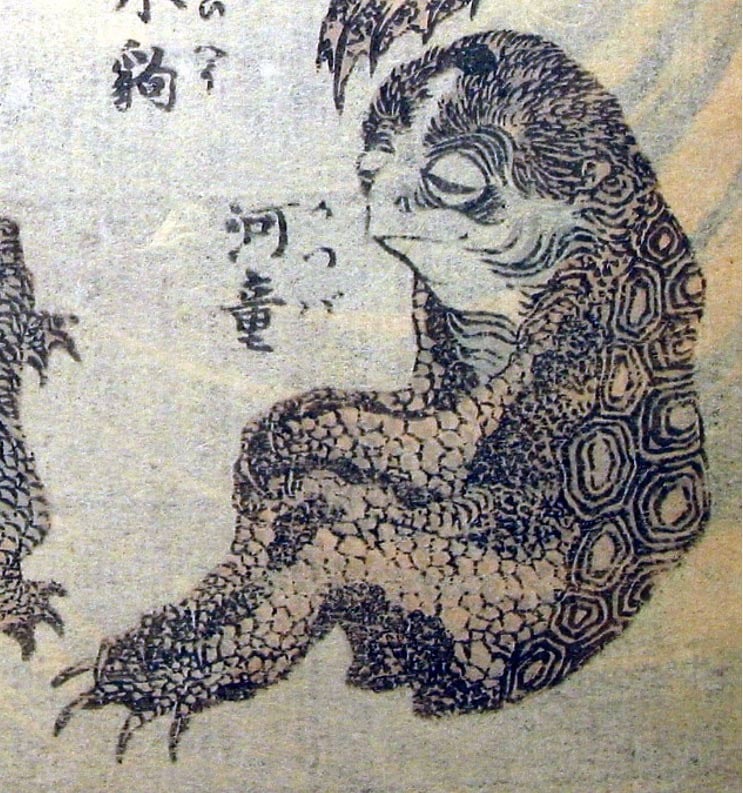
The Strange Origin of the Kappa: Japanese Water Imp
Many supernatural creatures are depicted in Japanese art and literature. Some seem realistic and might actually exist, since there have been witness sightings, while others are clearly composite creatures. Still others might have been created by storytellers to explain seemingly inexplicable phenomena. Such creatures include yuki-onna (snow women), who lure young men out of their beds at night and into the mountains where they freeze to death, and kitsune (foxes) which are thought to be shape shifters, often assuming the form of beautiful young women. Even today in northern Japan, some people who are suffering from psychological issues are thought to be possessed by foxes. Where some of these ideas originated is unknown. And in some unique cases, there are many possible origins for a particular creature’s existence, with evidence to back up all such possibilities. This is the case with the kappa (water imp).
The size of a small child, it has greenish skin and is sometimes artistically depicted with a turtle shell or fish scales, even though witness reports never indicate such scales or shell. It is likely that this artistic embellishment was put into place to indicate that it is, in fact, a water-abiding creature. It supposedly lives in lakes, ponds, and sometimes rivers, and it is generally always found in the water or next to it. This is due to another unusual attribute that the creature has. The kappa is described as having an indentation on the top of its head. While this indentation is filled with water, it is much stronger than a normal human being, but if it empties, it becomes as weak as a human child and can be defeated easily.

A Japanese bestiary drawing depicting a Kappa demon (c. 1760 – 1849). Public Domain
It is said this creature taught humans how to set bones. According to legend, there was once a kappa that looked especially like a human child. It coaxed many to the water, pretending that it wanted to play pull-finger. Once they touched its hand, it grabbed them and drowned them. To stop this mischievous creature, a villager approached on horseback and when the kappa invited him to the river bank, he did so, and reached out to grab the kappa’s finger. As soon as the man took hold, he spurred the horse into a gallop, dragging the creature away from the river and spilling the water that filled the indentation on its head. Thus weakened, the creature begged for its life, promising to teach the man something of value in return. It taught him the art of bone setting, and it further promised to never harm any human being in the area again (Davis, 1992). This is not the only time a kappa was said to have been controlled by means of emptying the water from the top of its head. The creature is considered especially polite, even to its intended victims. If a person bows to it, it will bow back, generally spilling its water and making it weak.
- Are mummified remains of unidentified creature proof of the mythological Kappa?
- The Age of the Gods: The Legendary History of Japan
- The Seven-Branched Sword: The Mystical Ceremonial Sword of Japan
Beyond occasionally drowning people, the creatures has been thought to rape women and exsanguinate humans and other creatures. Like a vampire, it sticks its teeth into human and animal flesh and drinks the blood. However, these creatures do it in an unusual way. Vampires and vampiric creatures are found in cultures all over the world, but this might be the only one that prefers to feed from anuses. This is why, even today in rural areas, humans or animals found in or near bodies of water with distended anuses are thought to have been victims of kappa attacks (Piggott, 1969).
To protect their children, some Japanese parents continue to inscribe their children’s names onto cucumbers, which they float downriver; this is because the kappa are supposed to love cucumbers, and after receiving the gift, they leave the families alone. This legend is the reason a cucumber roll is called a kappa-maki (kappa roll) instead of a kyuri-maki (cucumber roll).

Kappa astride turtle, by artist Naito Toyomasa (1773-1856) (Image is in the public domain. Made available as part of the Wikimedia Creative Commons license)
Another bizarre story highlights the kappa’s fascination with anuses. One evening, a kappa emerged from the water and began exploring a nearby farm. In the field, it saw a tethered cow. Sneaking up on it from behind, it jammed its entire arm up the cow’s rectum, and naturally, the cow jumped and began running around the field. The kappa’s arm was trapped, so it was thrown in various directions, thus spilling the water in its head indentation and making it weak. In its weakened condition, the cow’s thrashing ripped its arm clear off, and it scurried back to the river without it. The farmer was inside at the time of this alleged event, and he came outside to see what the commotion was. Finding the arm, he was naturally shocked, but he took it back inside with him, wondering what on earth could have occurred. Later that evening, the creature returned to the house and presented itself in front of the farmer. It begged for the arm, explaining that it only had three days to reattach it or it was gone forever. The man made the creature promise that it would never harm another human being or animal in the area, and once it acquiesced, he handed over the much desired appendage (Kappa, 2013).




